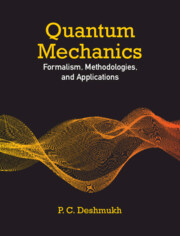‘Pranawa, a well-known atomic physicist and a great teacher of quantum mechanics over decades, offers an excursion to the quantum world. He shares anecdotes, questions, solved problems and insights, in a non-traditional fashion. One gets a glimpse of quantum complexities. In excursions, some preparation and learning a little bit about the places of visit helps enormously. Similarly, a familiarity with quantum mechanics will help the students to appreciate the difficult subject presented in the book. I learned Feynman's path integral method somewhat late. It made lot of sense and helped my research. Pranawa's book, thankfully introduces path integral method, early in the beginning. Pranawa's book is a Lego Box with precious pieces. Students and teachers can build their own quantum world using the pieces. There is a lot to be gained from this book for hard-working students.'
G. Baskaran - The Institute of Mathematical Sciences
‘Quantum Mechanics by Professor Deshmukh is a didactic book about basic QM, with the classical topics often illustrated by contemporary applications, punctuated with gems stemming from the Author research activity in atomic physics as well as fundamental problems. As example, after a detailed presentation of the Feynman's path integral formulation, a thorough discussion is given of geometrical phases, the Aharonov-Bohm effect including a numerical simulation and the connection with classical mechanics illustrated via a Foucault pendulum. Even for the quantum well a new approach via the Lambert W function is presented. Atomic structure and processes are more detailed than usual, including discussion of continuum states, dynamical symmetries and relativistic aspects. The style is leisurely, not overly formal, and you feel the teacher guiding you behind the shoulder, not shying from occasional longer derivations, but always with enough details to make for smooth sailing. A solid first approach for all students, especially recommended for further study in the quantum theory of matter and allied sciences.'
Piero Decleva - Dipartimento di Scienze Chimiche, Universita' di Trieste
‘It is often said that it is not possible to really understand Quantum Mechanics. This might be true, but with enough effort it is certainly possible to learn to master its machinery and use it to explain physical phenomena and develop new technology. Professor Pranawa Deshmukh writes in this book: ‘Quantum theory may shock and confuse us, but it is a successful theory of the physical world. It is cast in a mathematical framework which must be learned with patience and rigour'.'
Eva Lindroth - Department of Physics, Stockholm University
‘Professor Deshmukh is well placed to author this text, as he has extensive teaching experience in both classical and quantum mechanics. Throughout the book, the author consistently communicates his own excitement and wonder at quantum mechanics as a fundamental description of nature. Following his previous book Foundations of Classical Mechanics he elucidates the challenges and achievements of quantum theory. The early chapters introduce the basics of quantum theory and introduce the reader to non-relativistic and relativistic versions. The later chapters tackle interesting applications ranging from one-electron and many-electron atoms, to quantum collisions and up to date topics such as quantum information (entanglement) and computing. His inclusion of very detailed derivations accompanied by insightful physical explanations makes the book very suitable for self-study or as a graduate text.'
Eugene Kennedy - School of Physical Sciences, Dublin City University
‘This textbook on Quantum Mechanics (QM) follows a well-received CUP edition of the 'Foundations of Classical Mechanics' by the same author. While numerous texts on QM exist, the present book brings a fresh perspective given by a practicing atomic physics theorist with a wide range of research interests. The book is built from the historical background of QM up to the most recent applications including quantum information and computation. In this historical journey, the key milestones of QM are marked including the hydrogen atom, Feynman path integrals, light-matter interaction and scattering of atomic particles. A loving attention to detail and meticulous derivations make this book a pleasant and useful reading which will benefit both the students and practicing researchers.'
Anatoli Kheifets
Source: Research School of Physics, The Australian National University



